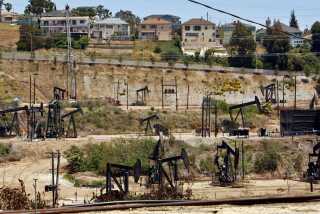Squeezing Oil From Wells That Others Give Up On
FORT WORTH â Engineers who specialize in finding leftover pockets of oil are the Zen masters of the oil industry.
They know theyâll never hit the big strike, and thatâs all right. Instead, they methodically and patiently flush petroleum from wells that have long since been abandoned by the energy giants.
âWe go out to these large fields where the big companies took the low-hanging fruit,â said Jeff Johnson, chief executive of Fort Worth-based Cano Petroleum. âIn our blue-collar way -- itâs not sexy -- but weâre bringing these fields back to life.â
Cano is one of 5,000 independent oil companies that are picking up the scraps left behind by larger corporations using expensive and risky techniques that the industry calls âenhanced oil recoveryâ -- EOR for short -- on old, low-production wells. For every barrel of oil produced in the United States there are two barrels left behind, and with a per-barrel pricetag of nearly $60, the hunt becomes even more lucrative.
With U.S. oil production on the decline, and energy from alternative sources still a small part of the supply picture, experts are pulling for companies such as Cano.
âRenewable energy is a great idea, but the fact is that weâre not there yet,â said Alesha Leemaster, spokeswoman for the Interstate Oil and Gas Compact Commission, which represents the governors of states that produce oil and natural gas. âItâs so important that we get those extra resources out of the ground.â
This spring, Cano acquired a field in Central Texas that was abandoned nearly 20 years ago. Wooden derricks that littered the storied Desdemona site during its oil-boom heyday of the 1920s had long since been sold for firewood when Johnson laid down $8 million for the field, which covers more than 10,000 acres.
Today, Johnsonâs company is using enhanced recovery techniques to pull 80 barrels of oil a day from Desdemonaâs 60 wells, or about 1.3 barrels per well. These are known as stripper wells -- wells that yield less than 10 barrels of oil a day -- and Desdemona is riddled with them.
âStripper wells are huge in this country,â said Jeff Eshelman, spokesman for the Independent Producers Assn. of America. âTheyâre the equivalent of what we import from Saudi Arabia each year.â
In 2003, according to the most recent data available, the nationâs 393,463 stripper wells produced 313 million barrels, or about 15% of domestic, onshore oil production in the contiguous 48 states. Most of the countryâs stripper wells are in Texas, Oklahoma and California, with half of Californiaâs 42,000 oil wells classified as strippers.In contrast to the stripper wellsâ output, many larger wells that are being worked over by the likes of Chevron Corp. yield more than 100 barrels a day, according to Iraj Ershaghi, director of the Center for Interactive Smart Oilfield Technology at USC.
âThere are going to be more and more companies looking atâ enhanced oil recovery, Ershaghi said. âThe new enhanced oil recovery processes were not put into practice in the â80s and â90s because it wasnât cost-effective -- they were expensive processes and oil was affordable. But now, you have to explore different environments or revisit mature fields.â
But not everyone is convinced enhanced recovery on these stripper wells can have much effect on the nationâs oil production.
âThe problem with a lot of these things, itâs actually very small numbers in the grand scheme of things,â said Leta Smith, senior consultant for IHS Energy, an oil and gas consulting service.
Johnson, who in a former career raised financing for energy projects, has heard the doubts for years. After all, he founded Cano in 1999, just before the price of oil crashed to $10 a barrel.
Even when critics said it was too expensive and not profitable, Johnson continued to gear Cano entirely toward enhanced recovery from proven fields.
âThey said, âWhy isnât anyone else doing it?â â he said.
Now, the Lubbock native is heading a 14-person company with $17 million in assets, 3.6 million barrels of proven reserves, and no long-term bank debt. He is also in charge of properties on which there is no exploration risk: All Canos wells once were proven producers.
In a corporate rite of passage, Johnson rang the opening bell of the American Stock Exchange on July 12. Cano went public last year and in May migrated to the Amex.
There are a variety of methods by which to grab hold of remaining oil pockets in a well. Companies pump carbon dioxide, water or steam into old wells to push more oil out of the rock and up to the service. Sophisticated computer simulations can spot caches of oil hidden inside rock that can then be accessed by drilling out from a nearby well.
Cano mostly relies on a process known as alkaline-surfactant-polymer, which is used to get the last 16%-25% of oil out of the rock.
First, the wells are flooded with water and then a soap-like chemical is pumped underground that loosens the oil molecules from the rock -- like dishwashing soap prying greasy residue off a lasagna pan. Finally, the oil is separated from the water and sucked up out of the ground. Sometimes, engineers actually use an industrial-sized vacuum to pull the hard-to-get oil caches out.
Using this technique, Canoâs 2,601-acre field in Nowata, Okla., is producing 77,000 barrels of fluid a day, out of which the company is pulling 250 barrels of oil daily. âThis isnât thick and tarry oil,â said John Lacik, Canoâs production, safety, health and environmental coordinator. âItâs real pretty, greenish-gold and real lightweight.â
Canoâs active fields are mainly in Texas and Oklahoma, and the company is on the prowl for more. âThere are good opportunities in California, and weâre looking at acquisitions there,â Johnson said.
Johnson estimates that Desdemona has almost 100 billion barrels of oil in place, waiting for advanced extraction strategies.
Enhanced recovery isnât foolproof, though. In its stock prospectus, Cano warns investors that the volume and present value of its reserves âmay prove to be lower than we have estimated.â The prospectus also says Cano faces âstrong competition from larger oil and natural-gas companies, which makes it difficult to conduct profitable operations.â The company is not yet profitable. For the nine months ended March 31, it reported a $2.1-million loss on revenue of $3.8 million.
Another difficulty for the enhanced recovery industry is the shortage of specialists. In recent years, natural gas became the industryâs darling. So even though enhanced recovery training remains a requirement for undergraduate petroleum engineers, few have been exposed to actual implementation of the process.
Enhanced oil recovery âtakes specialized training,â Smith said. âItâs going to take a little bit of effort on somebodyâs part to bring in a consultant to do certain types of EOR.â
That leaves two types of enhanced recovery specialists in the market: recent graduates who have scant job experience or veterans of enhanced oil recovery -- and there are few old hands available. Cano managed to lure its vice president of operations and engineering, Tom Cochrane, away from Exxon Mobil Corp. last year.
âI have an expertise in mature oil properties,â he said on a recent afternoon at Canoâs office in downtown Fort Worth. âAnd it was either learn some new tricks or go someplace where they value my expertise.â
More to Read
Sign up for Essential California
The most important California stories and recommendations in your inbox every morning.
You may occasionally receive promotional content from the Los Angeles Times.










